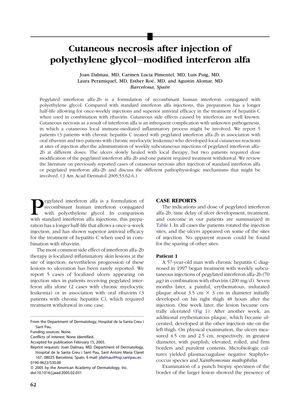Cutaneous Necrosis After Injection of Polyethylene Glycol–Modified Interferon Alfa
June 2005
in “
Journal of The American Academy of Dermatology
”
cutaneous necrosis pegylated interferon alfa-2b epidermal necrosis acute dermal inflammation tissue eosinophilia focal vasculitis thrombosis small vessel endothelial alterations livedoid necrosis erythema topical care hydrocolloid bandages skin necrosis PEG-interferon skin inflammation skin ulcers blood clots skin redness wound care bandages

TLDR Some patients receiving pegylated interferon alfa injections developed skin necrosis, requiring treatment adjustments or discontinuation.
In 2005, a study by Dalmau et al. reported that five patients receiving weekly subcutaneous injections of pegylated interferon alfa-2b developed cutaneous necrosis at the injection sites. These patients were being treated for chronic hepatitis C or chronic myelocytic leukemia. The resulting ulcers healed slowly with local therapy, but some patients required dose reductions or discontinuation of treatment. Histopathologic examination indicated epidermal necrosis, acute dermal inflammation, tissue eosinophilia, and focal vasculitis. Thrombosis in one biopsy suggested that small vessel endothelial alterations might contribute to the necrosis. The study emphasized the need for awareness of this complication and the potential necessity for changing injection sites and adjusting dosages. It was noted that while injection site pain is rare, skin reactions occur in up to 75% of patients, and in cases of livedoid necrosis, surgical treatment may be needed. Continuation of treatment at alternative sites is possible, but persistent skin issues may require stopping the drug. Prevention strategies include proper self-injection training, rotating injection sites, and monitoring for persistent erythema, with topical care and hydrocolloid bandages being effective treatments.



